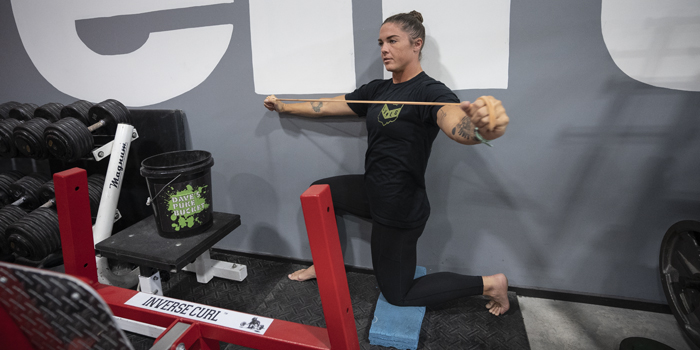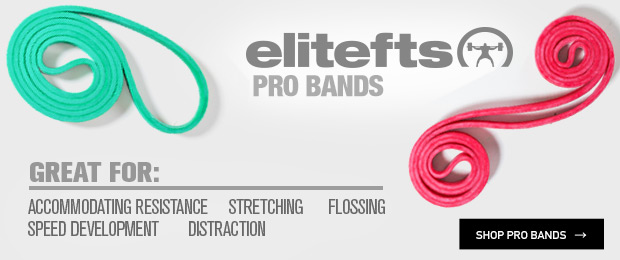
We've all seen the nine-year-old who karate chops his arms as he runs instead of swinging them. You first tell him, "Use your arms when you run," and you show him what it looks like. There's a glimmer of good form for a moment, but then the karate chops return when the child joins his friends for a race.
Or maybe you have someone squatting, and their knees are caving in. The first thing you do is cue them, "knees out." The squats begin to look better, so you add weight, yet the knees cave again. So, now you add a band around their knees, which seems to fix the problem. The band comes off, and as more weight is added to the bar, those knees end up clapping together again.
Why Isn't This Working?
I heard physical therapist Quinn Henoch on the Shrugged Barbell podcast say, "If there is no stressor, there is no adaptation." Whatever stimulus you provide your athletes to fix a movement error must be strong enough to elicit an adaptation.
Yes, cues can work and solve the problem. Sometimes the athlete needs to know the intent, what the exercise should look like, or be able to focus on one simple thing in their head while executing the movement. Feeling what the exercise is supposed to be like can also be helpful. To create a long-term change, there needs to be a stimulus strong enough to elicit an adaptation and groove the pattern.
If a movement error has been cued, but the athlete still cannot fix it, it is most likely a neuromuscular issue. So, if the knees keep caving in during a squat, the hip abductors and external rotators may not be strong enough, or they may be inhibited.
NEW: How to Smash Track PRs with Timed Squats
Stu McMillan says, "You can't fix a mechanical problem with a technical cue." If the tissue is not strong enough to create the movement you want, you need to strengthen that tissue. Just screaming at someone as they squat "KNEES OUT!" will not magically fix the issue if the tissue is incapable of it. If my bench press max is 200 pounds and I try 300 pounds, screaming "GET IT UP!" will not help me. Realistically, I'll need someone to pick the bar up off my chest. The tissue is not prepared for that load or stress.
This may seem obvious and hopefully, for many of you coaches, it is, but I don't think it is as obvious when it comes to sprinting and change of direction.
"Get your knees higher."
"Get off the ground quicker."
"Stay low when you are cutting."
These cues can all be good cues to some degree, but if the tissues involved in getting the knees higher, reacting quickly off the ground, or allowing an athlete to sink down on a cut are not prepared for that stress, then the desired motion will not occur.
How Can We Fix This Issue?
Determine what is limiting the motion you want to occur. If it is knee pick-up while sprinting, could it be hip flexor strength, hamstring "tightness" restricting the range of motion, or pelvic and spinal control?
If you want the athlete to sit down more while changing direction, do you notice a lack of ankle range of motion or knee strength in that position?
Whatever the limiting factor is, identify it and open up the needed range of motion. Whatever modality and medical professional you choose in this process, open up the desired range of motion, then stabilize it. I like the idea of using weight room exercises to solidify and stabilize a new range of motion, but simple isometrics have proved to be effective as well.
Remember, to adapt and maintain this position, the body needs to be stressed. Once both steps have been achieved, you can utilize this new range of motion at dynamic speeds—sprint and agility drills.
Is the problem completely solved?
In a human behavior and habits lecture from Jordan Peterson, he says that you create a neurological pathway in your brain when acting out a behavior. The more you continue this behavior, the stronger that pathway in your brain becomes. If you try to break this bad habit and change your behavior to a good habit, the other pathway will always be there; it will not disappear.
You can practice this behavior repeatedly and strengthen it, but in times of high stress, you will revert to the bad behavior. Human movement abides by the same rules. That pathway in the brain will always be there. The best way to minimize the chance of reverting to the poor movement is to continue exposing the movement to higher and higher stress levels.
Practical Implementation
Watch your athletes sprint and look for movement imperfections. You may notice insufficient right side hip flexion, which is a clear asymmetry compared to their left side. Assess them in the supine active straight leg raise and confirm the asymmetry. Have them perform some stretches that you trust to help them achieve the needed range of motion, like a band supine hamstring stretch. Strengthen the tissue in this range of motion by performing six repetitions of six-second isometric contractions (you can do as many repetitions as you like or for whatever time duration you like).
Next time this athlete is on the field for sprints, maybe they use this stretch and isometrics as part of their warm-up. Now, you can utilize this newly opened and stabilized range of motion at dynamic speeds by drilling A skips. Over time, gradually stress this range of motion more and more by adding in sprints, timed sprints, races, and some sort of chasing or cat-and-mouse game.
This is how you see the carryover of drills and exercises to the actual game. If there is no stress, there is no adaptation, and the system needs to be exposed to higher and higher levels of stress.
Steve Haggerty is a sports performance coach at Parkview Sports Medicine in Fort Wayne, Indiana, and an NFL Draft Prep specialist at Bommarito Performance Systems (BPS) in Miami, Florida. He spent the last two years at BPS working with NFL Pro Bowlers and MLB and NHL All-Stars in their off-season training.










